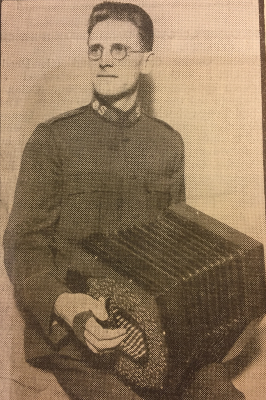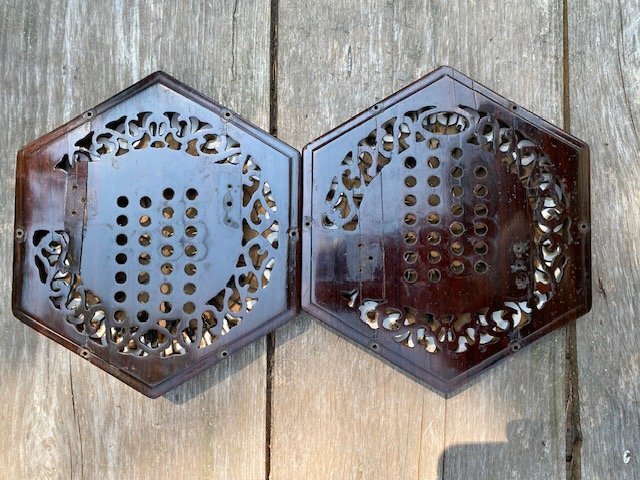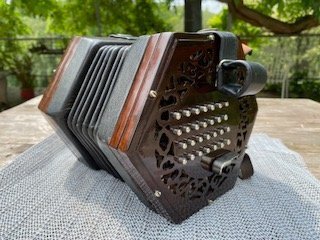-
Posts
1,670 -
Joined
-
Last visited
Posts posted by SteveS
-
-
I have at present an ebony-ended (raised ends) TT on my bench.
The ends are solid wood ebony.
There are many hairline cracks evident on the outside, and on inspection appear to go right through the wood.
There are many more hairline cracks on the inside than outside.
Any tips on how to handle this to stablise the cracks?
My current thinking is to open up the worst cracks slightly both sides with a knife (especially those that go right through) and force in some hot hide glue from both sides.
May be make a filler using hide glue and stained sawdust.
Then use a veneer with the grain going in the opposite direction to the grain of the ends, and glue this to the inside.
I will need to fill, stain, and refinish the ends.
-
Why not make 2 asymmetric concertinas - both prime numbers and mathematically related so as to form the secret and public keys of an asymmetric encryption key pair. Of course, you'd get to play one of them only if the other is present in the same room, otherwise, they'll just play jumbled up notes.
-
 1
1
-
-
How about this monster (picture from The Salvationist)

-
 1
1
-
-
I was tuning a baritone earlier today and I encountered for the first time an interesting variation on the low F in the place of the G#2 on the RHS.
This one has F2 on bellows pull and E2 on bellows push.
-
I'm selling another instrument from my collection.
This time a Wheatstone 56 key extended treble. It is a magnificent player - very fast action and bright responsive rivetted reeds.
I guess, this instrument could be from 1880s. No serial number.
This one used to be my regular squeeze until I got my first Aeola. I used to play this in sessions and in a ceilidh band when I lived in Edinburgh during 1990s.
Some history of the instrument:
I acquired it around 1992, and Colin Dipper did some maintenance work on it shortly afterwards.
An apparent historic professional repair has fixed damaged bolt holes - presumably, Wheatstone did this work.
I have serviced the instrument. I have repaired recently the severely cracked ends, and refinished them - these look as good as new now. When finishing the ends I stripped back the old shellac - which looked like it was brown button shellac, and refinished using a lighter amber shellac which I think accentuates the grain nicely, and improves the appearance of the ends.
Tuned to A=440Hz
One modification from standard - the low G# on the right-hand side is tuned to a low F.
Ready to play and enjoy.
There is no original case - but I'll see if I can find a suitable case to put it in.
I'm asking €2500.
Located in Piemonte, Italy.
-
11 hours ago, gcoover said:
Instruments with waxed-in reeds are also at risk in high-heat situations. Several years ago while performing on stage in 100+ weather in San Antonio, TX, reeds literally fell out of my Hohner pokerwork melodeon.
The first clue was hearing air instead of notes, and then the disconcerting realization that there were reeds jangling about at the bottom of the bellows. Needless to say, the tune ended early!
I saw a similar thing in a session at a UK festival once. The player took out his melodeon from the gig bag, and started to play - nothing - only a rattle from the unattached reeds. He apparently got it repaired the same day, there being an accordion repairer on-site at the festival's trade fair. So all was well in the end - but lesson learned.
-
Yesterday was so hot here in Italy that, left in the sun, the hide glue in my glue pot melted.
I didn't need to warm up the glue at all in my bain-marie.
Leaving an instrument in a car when it's so hot could well have disastrous consequences.
-
1 hour ago, Clive Thorne said:
Am I correct in that the main difference between a Flutina and melodeon is that the Push and pull notes are reversed?
Yes they are - I was thinking to make new reed pans for a flutina I have so that it plays
like a melodeon.
-
Here's a link to flutina reeds
File:Flutina-reeds.JPG - Wikimedia CommonsThe OP appears to me to be more likely flutina reeds than concertina.
-
 1
1
-
-
Square-ended reeds were also found in flutinas - a precursor to the diatonic button accordion (melodeon in UK).
Many pictures taken in US around the time of the Civil War feature sitters holding a flutina as a prop.
Could it be that these square-ended reeds belong to a flutina?
Early Wheatstone concertinas also featured square-ended reeds - but how prevalent were they in US?
I've never seen a photo with a sitter holding a concertina (that's not to say they don't/didn't exist).
-
I have recently finished the repair of split rosewood ends. The ends are solid rosewood, and splits of this type in ends made from this type of material are common.
This is a Wheatstone concertina from around 1885 (no serial number) and has rivetted steel reeds. It's amazingly fast to play and was my main squeeze for many years until I got my first Aeola. I played this instrument for ceilidhs and in sessions when I lived in Edinburgh.
When I bought it it had split ends then - whilst not structural and didn't affect the playability of the 'tina, the instrument was fairly unsightly to look at. I'd been meaning to repair the splits in the ends for over 25 years, and recently I got around to undertaking this repair.
Below are before and after pictures.
The repaired ends are supported underneath to prevent the splits from opening again and to stablise them. New wood was introduced into the splits. I have refinished the ends with French polish. I removed the old shellac and used a lighter shellac for my finishing, which I think brings out the colours of wood grain nicely. Weak parts of the fretwork broke away, so these needed to be fixed, as well as the introduction of a couple of instances of missing fretwork. I used hot hide glue for gluing the new wood and new fretwork.
Interestingly, a professional repair had been conducted in the past to repair the end bolt holes - maybe Wheatstone undertook that repair, and the ends I assume weren't split at that time. Colin Dipper also carried out some maintenance work on it around 1992 soon after I acquired the instrument.
If anyone is interested, I plan to sell this instrument.
Before

After
During
-
 3
3
-
-
-
I shall shortly have for sale from my collection, a metal-ended 60 key Aeola Baritone.
Currently undergoing full servicing (metal work cleaned, new pads, new valves, new thumb straps, tuning to A=440Hz), I expect to have it ready in about 2 weeks.
If a prospective buyer would like the tuning centred on other than A=440Hz (it's currently in approximately high pitch), then let me know asap before I start the tuning process.
I'll be asking €6000 for this instrument.
Located in northern Italy.
Here are some pictures taken before servicing
-
Thanks all for your replies.
I plan to make a test piece using 2.5mm leather and box stitching.
I also think a hard inner layer made from birch play is worth trying - lined with some rather nice velvet I got for lining a couple of wooden cases I made ages ago.
I'll post the results of my endeavours when I've completed my test piece
-
Wow! exactly what I have in mind. Thanks for posting.
I'm thinking to reinforce internally using birch ply rather than a card lamination - but I'll certainly look at the card option since I have loads of it 😀
-
52 minutes ago, SIMON GABRIELOW said:
Why not make a wooden case instead?
Simple sawn jointed box; avoiding the traditional hexagonal cases often seen. Also, just like your leather example, a square box enables instrument to be removed more easily ( I have found).
Wooden box will.protect concertina inside, and can be veneered also.
Wooden cases can be a good option, and they look great when veneered and French-polished.
IMO the traditional leather cases, are very attractive and add to the overall appearance of a good instrument contained within. Unfortunately, this is hard to appreciate nowadays since most leather cases are well over 100 years old and in varying degrees of poor condition.
As a beginner, I'll do some stitching tests on scrap/samples, then prototype a small box. If successful, I'll then move on to a full-size box, but will make templates first, sticking them together with tape to get a feel for the overall size of the end product, before I start cutting and stitching expensive leather.
-
I have a metal-ended Aeolo 60 key baritone that I'm servicing right now.
Should be available in 2 weeks or so.
Might it be of interest?
-
1 hour ago, Michael Marino said:
Is that a full leather box or is it a leather and veneer box? I have made leather and veneer boxes a long long time ago (I was teenager then). If it is only Leather that is going to be interesting as it is going to require a good bit of knowledge in leather craft. Best of luck and please keep us up to date if you do choose to make it.
It's leather externally (about 2mm thick leather), with wooden internal box.
My thought is to see how it goes with 2mm leather (might be a challenge for a beginner) for my test piece.
If all goes well, when I come to make the first case, my thought is to reinforce the case internally using thin birch ply.
-
9 hours ago, AndyNT said:
Can you post a pic of the case you are hoping to copy?
Do you have any experience of sewing thick leather and have the necessary implements?
I've attached a pic of the case I might copy - this is for a baritone, but I have a treble that could use a case, so I'll just scale down accordingly.
I've been collecting leather working tools for some time, and have just recently bought a sewing kit with various needles, awls, and various coloured threads. I have edgers, skiving knives (and the facilities to sharpen them), and various punches used in leather sewing.
-
I've been thinking about making a leather case - copying an existing Wheatstone or Lachenal leather case as my starting point.
I've sourced leather for concertina parts and bellows - and got a few offcuts of leather sufficient for a small test box, using box sewing techniques.
Has anyone tried sewing a leather box?
Looking at the technique videos on YouTube it seems fairly straightforward (hence the need for a test box).
But I'm sure there are some things not explained in the videos that I'll run up against.
I'd appreciate any tips / advice.
-
2 hours ago, Seán Ó Fearghail said:
Yes Sandarac goes nicely in spirit varnishes but it makes the varnish a little softer. They often add it to fiddle varnish. It depends on the end result you want.
I'd read that gum sandarac will make the shellac a little harder - add too much and it becomes brittle.
Right now I'm not using any additive in my polish - the combination of shellac (and natural wax) and 99.9 degree ethyl alcohol seems to be producing a good finish.
-
2 hours ago, Sarah Cardin said:
If the screw doesn't hold firmly for the long run, I'll use the matchstick repair method mentioned by Chris Ghent.
Try using cocktail sticks - they tend to be made from a harder wood than that used for matchsticks.
-
 1
1
-
-
Does anyone use gum sandarac in their shellac finish?
Some say to add a small quantity to the shellac, others say to do the final polish coat with dissolved gum sandarac.
Instead of using gum sandarac, how about using shellac that hasn't been dewaxed?
-


.thumb.jpg.e5ef9a111c1064c0bbea848f22aab7fe.jpg)










Treating hairline cracks
in Instrument Construction & Repair
Posted
Doing a bit of research, super thin CA glue might work. Hopefully, it should run into the cracks.
(I've seen luthiers using this for cracks in guitars)